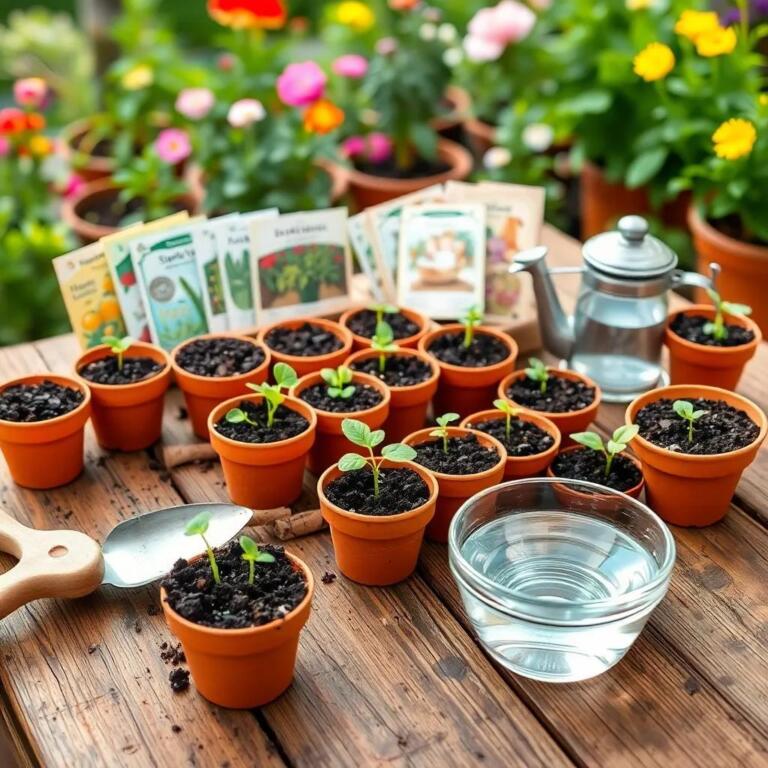Have you ever wondered how long it takes for those tiny seeds to turn into lovely plants? Whether you’re a seasoned gardener or just starting out, understanding seed germination is the key to a thriving garden. Join me as we explore the fascinating world of seeds and discover tips to make your gardening journey a blooming success!
Factors Influencing Seed germination time
When it comes to getting those tiny seeds to sprout, there are several factors that come into play. Understanding these can really help you become a better gardener!
- Seed quality: Fresh seeds are like a fine wine; the younger,the better! Seeds that are old or damaged may not sprout at all. So, always buy from reputable sources. Trust me, it makes a world of difference!
- Water: Seeds need hydration to start the germination process. When they soak up water, it wakes them up from their sleepy state. But remember, just like us after a long night, too much water can be a problem too! Find that sweet spot where the seeds are moist but not soggy.
- Temperature: Just like we have our favorite temperatures to lounge around, seeds also have preferences. Most seeds like it warm,around 65-75°F (18-24°C). If it’s too chilly or too hot, they may just decide to take their time sprouting. Make sure to check what temperature range your seeds prefer!
- Light: Some seeds crave light, while others prefer a bit of darkness. This can be a game-changer for sprouting. Do a little research on the specific needs of your seeds to ensure they get the right amount of light.
- Oxygen: Just like we need fresh air, seeds need oxygen during germination. good soil aeration is key. If your soil is too compacted, it can choke the seeds and delay their growth.
By keeping these factors in mind, you can create the perfect little surroundings for your seeds to sprout and thrive, leading you on your gardening adventure with beautiful plants!
Common Seeds and Their Germination Timelines
Knowing how long different seeds take to germinate can make your gardening experience so much more enjoyable! Let’s talk about some common seeds and their timelines because who doesn’t want to know when to expect those green shoots?
- Lettuce: This speedy little fellow can sprout in just 7 to 14 days. It’s perfect for impatient gardeners like me! Just plant, water, and watch those greens pop up!
- Tomatoes: Give these sweeties about 5 to 10 days to make an appearance.They thrive in warmth, so make sure they’re cozy!
- Carrots: They might take a bit longer, usually around 10 to 21 days. The wait is worth it,especially when you’re munching on those crunchy carrots later!
- Peppers: These colorful delights typically germinate in 10 to 14 days. They love warmth, so starting them indoors is a great option!
- Beans: Depending on the variety, beans can sprout in 7 to 14 days. They’re pretty forgiving if you keep the soil warm and moist.
- Zucchini and Cucumbers: Both of these garden favorites typically take 7 to 10 days. Zucchini seems to grow faster than I can eat it, but that’s a happy problem!
By knowing these timelines, you can plan your gardening tasks better. Imagine waiting just a week or two to see your little seedlings pop up! How exciting! So, get those seeds planted, and let the countdown begin to your lovely garden!

Tips for Accelerating Seed Sprouting
We all want our seeds to sprout quickly and get our gardens growing, right? There are some fun and easy ways to speed up the germination process! Here’s a little guide to help you out:
- Pre-soaking: One of my favorite tricks is to pre-soak seeds before planting. Just place them in a bowl of water for a few hours or even overnight. This softens the seed coat and wakes them up! Its like giving them a nice bath to prepare for their big adventure.
- Scarification: Some seeds have tough outer shells that need a little encouragement to sprout. This is where scarification comes in. Gently scratch the seed coat with a file or sandpaper to help. It’s like giving them a little nudge to say, “Hey, it’s time to grow!”
- Soil Preparation: The right soil can make a huge difference. Make sure it’s loose, well-draining, and rich in nutrients. I love mixing in some compost to help my seeds feel right at home. When the soil is cozy, the seeds will feel motivated to sprout!
- Temperature Control: Keep an eye on the temperature in your gardening area.Most seeds prefer a warm spot to germinate, around 65-75°F (18-24°C). If it’s chilly,consider using a heat mat or placing them in a sunny window. Warmth is like a cozy blanket for seeds!
- Optimal Moisture: Water is key. Keep the soil moist (but not soggy) to help the seeds absorb what they need. A spray bottle can be handy for gently misting the soil without overdoing it.
- Use of Grow Lights: If you’re starting seeds indoors, consider using grow lights. They mimic natural sunlight and can speed up germination. Your seeds will thank you for the extra light and warmth!
By following these tips,you’ll create a nurturing environment that encourages faster sprouting. Get ready to see those lovely little greens pop up!
Challenges That Delay Seed Germination
Even the best gardeners face some hiccups when it comes to getting seeds to sprout. If you’re experiencing delays in germination, don’t fret! Here’s a rundown of common challenges and how to tackle them:
- Improper Temperature: If the temperature is too cold or too hot, seeds may just sit there sulking. Make sure you know your seeds’ temperature preferences. If they’re not happy, they might refuse to grow!
- Insufficient Water: While overwatering can drown seeds, under-watering can do just as much harm. Make sure the soil is consistently moist but never soggy. If it’s too dry, seeds will struggle to absorb water.
- Poor Soil Conditions: Soil that is compacted or lacks nutrients can slow things down.If the soil is too dense, seeds may have a hard time pushing through. Take the time to prepare a well-structured, nutrient-rich environment for your seeds.
- Seed Dormancy: Some seeds are naturally dormant and need special conditions to wake up.This might mean a cold period (stratification) or exposure to specific light conditions. Research the seeds you’re working with so you can meet their unique requirements!
- Weed Competition: If your garden area is filled with weeds, they might potentially be hogging all the resources. Weeds compete for moisture,sunlight,and nutrients. Before planting, make sure to clear the area of any unwelcome guests!
- Old or Poor-Quality Seeds: If your seeds are old or damaged, they might not sprout at all. It’s best to buy fresh seeds from trusted sources. A little investment goes a long way in getting those greens in your garden!
By recognizing and addressing these challenges, you’ll be one step closer to a thriving garden. Don’t get discouraged! Rather, take this as an opportunity to learn and improve your gardening game. Happy planting!
Best Practices for Seed Care and Management
Now that we’ve tackled the challenges, let’s talk about some best practices to keep your seeds happy and healthy! Following these tips can lead to a flourishing garden:
- Labeling: Keep track of what you planted! Use garden markers or tags to label each type of seed. This way, you’ll know what to expect as they start sprouting. Plus, it adds a personal touch to your garden!
- Regular Monitoring: Check on your seeds regularly. Observe the moisture levels and monitor for any signs of pests or diseases. The sooner you catch a problem, the easier it will be to address it!
- Thinning Seedlings: once your seeds sprout, don’t forget to thin them out. If they are too crowded, they will compete for resources.Gently remove the weaker seedlings to give the stronger ones more room to grow!
- Watering Wisely: Water your seeds in the morning to prevent evaporation. Don’t forget to adjust your watering schedule as the plants grow—young seedlings need different care than established plants.
- Hardening Off: If you’re moving indoor seedlings outside, don’t just toss them into the garden! Take time to acclimate them to outdoor conditions by gradually increasing their exposure to sunlight and wind over 5-7 days. It helps them adjust and thrive in their new environment.
- Stay Patient and Enjoy: Remember, gardening is a journey. Be patient while you wait for seeds to sprout and grow. Enjoy the process! Take time to observe, admire, and learn about the plants you’re nurturing.
By implementing these best practices, you’ll foster a healthy environment for your seeds and watch your garden flourish. Happy gardening!

